Papers by Claude Prablanc
Vision Research, 1975
The saccadic response to a peripheral step stimulus is composed of a main saccade. and a correcti... more The saccadic response to a peripheral step stimulus is composed of a main saccade. and a corrective saccade with a shorter latency. When a single peripheral pulse stimulus is presented with ;I duration shorter than the latency of the response. the main saccade is not followed by a corrective one. though it is inaccurate. However when a second pulse synchronized to the first saccade is presented within some degreesaround the new visual axis. it elicits a saccadic correction with a short latency. If the second pulse is presented at a larger retinal eccentricity. the saccadic correction is performed with a normal latency.
Behavioural Brain Research, 1989
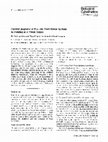
Biological Cybernetics, 1979
In a task requiring an optimal hand pointing (with regards to both time and accuracy) at a periph... more In a task requiring an optimal hand pointing (with regards to both time and accuracy) at a peripheral target, there is first a saccade of the eye within 250 ms, followed 100 ms later by the hand movement. However the latency of the hand movement is poorly correlated with that of the eye movement. When the peripheral target is cut off at the onset of the saccade, there is no correlation between the error of the gaze position and the error of the hand pointing. This suggests an early parallel processing of the two motor outputs. The duration of hand movement does not change significantly when subjects either see or not see their hand (closed or open loop). In the open loop situation, the undershoot of the hand pointing increases with target eccentricity, whatever the subjects are allowed or not to do a saccade toward the target. It suggests that the encoding of eye position by itself is a poor index for an accurately guided movement of the hand.
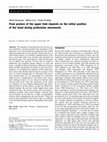
Experimental Brain Research, 1998
The question of knowing how the nervous system transforms a desired position and orientation of t... more The question of knowing how the nervous system transforms a desired position and orientation of the hand into a set of arm and forearm angles has been widely addressed during the last few decades. Despite this fact, it still remains unclear as to whether a unique posture of the arm is associated with every location and orientation of the hand in space. The main objective of the present study was to address this question. To this end, we studied a prehension task requiring human subjects to reach and grasp a cylindrical object presented at different locations, along variable orientations. In contrast to previous investigations, we considered the influence of the initial position of the hand. Results showed that the posture of the arm: (1) varied systematically as a function of the movement starting point; (2) was stereotyped for a particular subject given a configuration of the object and a movement starting location; (3) was altered at both the distal and proximal levels when the orientation of the object was changed; (4) was similarly influenced by the experimental factors in all the subjects, except one. When considered together, the previous results support three main conclusions: First, the nervous system solves the joint redundancy problem using fixed strategies. Second, these fixed strategies do not provide a single correspondence between hand configuration and arm posture. Third, the position and orientation of the hand in space are unlikely to be controlled through separate independent neural pathways.
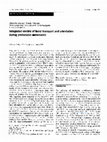
Experimental Brain Research, 1996
At a descriptive level, prehension movements can be partitioned into three components ensuring, r... more At a descriptive level, prehension movements can be partitioned into three components ensuring, respectively, the transport of the arm to the vicinity of the target, the orientation of the hand according to object tilt, and the grasp itself. Several authors have suggested that this analytic description may be an operational principle for the organization of the motor system. This hypothesis, called “visuomotor channels hypothesis,” is in particular supported by experiments showing a parallelism between the reach and grasp components of prehension movements. The purpose of the present study was to determine whether or not the generalization of the visuomotor channels hypothesis, from its initial form, restricted to the grasp and transport components, to its actual form, including the reach orientation and grasp components, may be well founded. Six subjects were required to reach and grasp cylindrical objects presented at a given location, with different orientations. During the movements, object orientation was either kept constant (unperturbed trials) or modified at movement onset (perturbed trials). Results showed that both wrist path (sequence of positions that the hand follows in space), and wrist trajectory (time sequence of the successive positions of the hand) were strongly affected by object orientation and by the occurrence of perturbations. These observations suggested strongly that arm transport and hand orientation were neither planned nor controlled independently. The significant linear regressions observed, with respect to the time, between arm displacement (integral of the magnitude of the velocity vector) and forearm rotation also supported this view. Interestingly, hand orientation was not implemented at only the distal level, demonstrating that all the redundant degrees of freedom available were used by the motor system to achieve the task. The final configuration reached by the arm was very stable for a given final orientation of the object to grasp. In particular, when object tilt was suddenly modified at movement onset, the correction brought the upper limb into the same posture as that obtained when the object was initially presented along the final orientation reached after perturbation. Taken together, the results described in the present study suggest that arm transport and hand orientation do not constitute independent visuomotor channels. They also further suggest that prehension movements are programmed, from an initial configuration, to reach smoothly a final posture that corresponds to a given “location and orientation” as a whole.
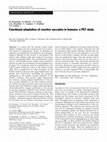
Experimental Brain Research, 2000
It is known that the saccadic system shows adaptive changes when the command sent to the extraocu... more It is known that the saccadic system shows adaptive changes when the command sent to the extraocular muscles is inappropriate. Despite an abundance of supportive psychophysical investigations, the neurophysiological substrate of this process is still debated. The present study addresses this issue using H215O positron emission tomography (PET). We contrasted three conditions in which healthy human subjects were required to perform saccadic eye movements toward peripheral visual targets. Two conditions involved a modification of the target location during the course of the initial saccade, when there is suppression of visual perception. In the RAND condition, intra-saccadic target displacement was random from trial-to-trial, precluding any systematic modification of the primary saccade amplitude. In the ADAPT condition, intra-saccadic target displacement was uniform, causing adaptive modification of the primary saccade amplitude. In the third condition (stationary, STAT), the target remained at the same location during the entire trial. Difference images reflecting regional cerebral-blood-flow changes attributable to the process of saccadic adaptation (ADAPT minus RAND; ADAPT minus STAT) showed a selective activation in the oculomotor cerebellar vermis (OCV; lobules VI and VII). This finding is consistent with neurophysiological studies in monkeys. Additional analyses indicated that the cerebellar activation was not related to kinematic factors, and that the absence of significant activation within the frontal eye fields (FEF) or the superior colliculus (SC) did not represent a false negative inference. Besides the contribution of the OCV to saccadic adaptation, we also observed, in the RAND condition, that the saccade amplitude was significantly larger when the previous trial involved a forward jump than when the previous trial involved a backward jump. This observation indicates that saccade accuracy is constantly monitored on a trial-to-trial basis. Behavioral measurements and PET observations (RAND minus STAT) suggest that this single-trial control of saccade amplitude may be functionally distinct from the process of saccadic adaptation.
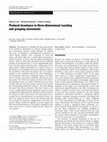
Experimental Brain Research, 2000
The question of whether the final arm posture to be reached is determined in advance during prehe... more The question of whether the final arm posture to be reached is determined in advance during prehension movements remains widely debated. To address this issue, we designed a psychophysical experiment in which human subjects were instructed to reach and grasp, with their right arm, a small sphere presented at various locations. In some trials the sphere remained stationary, while in others (the perturbed trials) it suddenly jumped, at movement onset, to a new unpredictable position. Our data indicate that the final configuration of the upper limb is highly predictable for a given location of the sphere. For movements directed at stationary objects, the variability of the final arm posture was very small in relation to the variability allowed by joint redundancy. For movements directed at "jumping" objects, the initial motor response was quickly amended, allowing an accurate grasp. The final arm posture reached at the end of the perturbed trials was neither different from nor more variable than the final arm posture reached at the end of the corresponding stationary trials (i.e. the trials sharing the same final object location). This latter result is not trivial, considering both joint redundancy and the motor reorganization imposed by the change in sphere location. In contrast to earlier observations, our data cannot be accounted for by biomechanical or functional factors. Indeed, the spherical object used in the present study did not constrain the final arm configuration or the hand trajectory. When considered together, our data support the idea that the final posture to be reached is planned in advance and used as a control variable by the central nervous system.
Vision Research, 1988
The kinematics of centrifugal and centripetal saccadic eye movements were quantified in human sub... more The kinematics of centrifugal and centripetal saccadic eye movements were quantified in human subjects. The maximum velocity of centripetal saccades increased with the eccentricity of the orbital starting point and was systematically higher than that of centrifugal saccades starting from primary orbital position. The slope of this linear increase was related to target step amplitude (2.6 and 3.9 deg/sec/deg for 20 and 30 deg, respectively). Despite these velocity changes, saccade amplitude was maintained by corresponding variations of the duration of deceleration. These findings, which are relevant with respect to saccadic control theories, indicate that initial eye position must be considered before comparing saecades based on their kinematic properties.
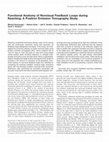
Reaching movements performed without vision of the moving limb are continuously monitored, during... more Reaching movements performed without vision of the moving limb are continuously monitored, during their execution, by feedback loops (designated nonvisual). In this study, we investigated the functional anatomy of these nonvisual loops using positron emission tomography (PET). Seven subjects had to "look at" (eye) or "look and point to" (eye-arm) visual targets whose location either remained stationary or changed undetectably during the ocular saccade (when vision is suppressed). Slightly changing the target location during gaze shift causes an increase in the amount of correction to be generated. Functional anatomy of nonvisual feedback loops was identified by comparing the reaching condition involving large corrections (jump) with the reaching condition involving small corrections (stationary), after subtracting the activations associated with saccadic movements and hand movement planning [(eye-arm-jumping minus eye-jumping) minus (eye-arm-stationary minus eye-stationary)]. Behavioral data confirmed that the subjects were both accurate at reaching to the stationary targets and able to update their movement smoothly and early in response to the target jump. PET difference images showed that these corrections were mediated by a restricted network involving the left posterior parietal cortex, the right anterior intermediate cerebellum, and the left primary motor cortex. These results are consistent with our knowledge of the functional properties of these areas and more generally with models emphasizing parietal-cerebellar circuits for processing a dynamic motor error signal.

Journal of Motor Behavior, 1993
Two experiments were conducted to determine the spatial and temporal organization of the arm traj... more Two experiments were conducted to determine the spatial and temporal organization of the arm trajectory in human subjects as they pointed to single- and double-step target displacements. Subjects pointed either without (Experiment 1) or with (Experiment 2) vision of their moving hand throughout the trial. In both experiments, target perturbation occurring in double-step trials was clearly perceived by the subjects and was randomly introduced either at the onset or at peak velocity of hand movement. Regardless of whether or not visual reafference from the pointing hand was available, subjects corrected the trajectory of their moving hand to accommodate the double-step. Moreover, asymmetrical velocity profiles were observed for responses to both types of target, with or without vision of the moving hand. The acceleration phase was a fixed pattern independent of the type of step stimulation. However, a clear dissociation, both in the deceleration phase and accuracy of responses to double-step targets, emerged according to the timing of target perturbation. When targets were perturbed at the onset of hand movement, subjects modulated the deceleration phase of their response to compensate for 88 to 100% of the second target displacement. In contrast, when targets were perturbed at peak velocity of hand movement, subjects were unable to modulate the deceleration phase adequately and compensated for only 20 to 40% of the perturbation. These results suggest that motor error is dynamically evaluated during me acceleration phase of a movement toward a perturbed target, allowing amendments to the trajectory to be performed during the deceleration phase. This main corrective process appears to be basically independent of visual reafference from the moving hand.

1. A fundamental question about motor control is related to the nature of the representations use... more 1. A fundamental question about motor control is related to the nature of the representations used by the nervous system to program the movement. Theoretically, arm displacement can be encoded either in task (extrinsic) or in joint (intrinsic) space. 2. The present study investigated the organization of complex movements consisting of reaching and grasping a cylindrical object presented along different orientations in space. In some trials, object orientation was suddenly modified at movement onset. 3. At a static level, the final limb angles were highly predictable despite the wide range of possible postures allowed by articular redundancy. Moreover, when object orientation was unexpectedly modified at movement onset, the final angular configuration of the limb was identical to that obtained when the object was initially presented along the orientation reached after the perturbation. 4. At a dynamical level, a generalized synergy was observed, and tight correlations were noted between all joint angles implicated in the movement with the exception of elbow flexion. For this joint angle, which did not vary monotonically, strong partial correlations were however observed before and after movement reversal. 5. These results suggest that natural movements are mostly carried out in joint space by postural transitions.
Experimental Brain Research, 1982
The time of occurrence of eye, head, and arm movements directed at the same visual target was mea... more The time of occurrence of eye, head, and arm movements directed at the same visual target was measured in five human subjects. The latency of activation of the corresponding neck and arm muscles was also measured. It appears that although the overt movements are sequentially ordered (starting with the eye movement, then the head and finally the arm) the EMG discharges are synchronous with respect to the eye movement onset. In addition, eye movement latency appears definitely (though weakly) correlated with either neck or arm EMG latencies. Neck and arm EMG latencies are also mutually correlated. These results indicate a clustering of segmental motor programs for target oriented actions.

Pointing accuracy of six human subjects was measured in two blocked conditions where the hand was... more Pointing accuracy of six human subjects was measured in two blocked conditions where the hand was either never visible (T: target only) or only visible in static position prior to movement onset (H+T: hand+target). It was shown in condition H+T that, viewing the hand prior to movement greatly decreased end-point variability compared with condition T. This effect was associated with a significant modification of the movement kinematics: the H+T condition induced a shortened acceleration phase with a corresponding lengthened deceleration phase, compared with the T condition. These results led us to the hypothesis that viewing the hand prior to movement onset allowed a decrease of pointing variability through a feedback process. This hypothesis was further tested by turning the target off during the deceleration phase of the movement at half peak velocity. It was shown that turning the target off had no effect upon the T condition but induced a significant increase of pointing variability in the H+T condition. This result suggests that vision of the static hand enhances the proprioceptive localization of the limb and allows for a better visual to kinesthesic feedback.

Experimental Brain Research, 1997
It is now well established that the accuracy of pointing movements to visual targets is worse in... more It is now well established that the accuracy of pointing movements to visual targets is worse in the full open loop condition (FOL; the hand is never visible) than in the static closed loop condition (SCL; the hand is only visible in static position prior to movement onset). In order to account for this result, it is generally admitted that viewing the hand in static position (SCL) improves the movement planning process by allowing a better encoding of the initial state of the motor apparatus. Interestingly, this wide-spread interpretation has recently been challenged by several studies suggesting that the effect of viewing the upper limb at rest might be explained in terms of the simultaneous vision of the hand and target. This result is supported by recent studies showing that goal-directed movements involve different types of planning (egocentric versus allocentric) depending on whether the hand and target are seen simultaneously or not before movement onset. The main aim of the present study was to test whether or not the accuracy improvement observed when the hand is visible before movement onset is related, at least partially, to a better encoding of the initial state of the upper limb. To address this question, we studied experimental conditions in which subjects were instructed to point with their right index finger toward their unseen left index finger. In that situation (proprioceptive pointing), the hand and target are never visible simultaneously and an improvement of movement accuracy in SCL, with respect to FOL, may only be explained by a better encoding of the initial state of the moving limb when vision is present. The results of this experiment showed that both the systematic and the variable errors were significantly lower in the SCL than in the FOL condition. This suggests: (1) that the effect of viewing the static hand prior to motion does not only depend on the simultaneous vision of the goal and the effector during movement planning; (2) that knowledge of the initial upper limb configuration or position is necessary to accurately plan goal-directed movements; (3) that static proprioceptive receptors are partially ineffective in providing an accurate estimate of the limb posture, and/or hand location relative to the body; and (4) that static visual information significantly improves the representation provided by the static proprioceptive channel.
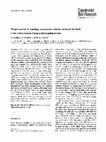
Experimental Brain Research, 1986
The spatial and temporal organization of hand and eye movements were studied in normal human subj... more The spatial and temporal organization of hand and eye movements were studied in normal human subjects as they pointed toward small visual targets. The experiment was designed to assess the role of information about target position in correcting the trajectory of the hand when view of the hand was not available. To accomplish this, the duration of target presentation was systematically varied across blocks of trials. The results of this experiment showed that pointing movements were about 3 times more accurate when the target was present throughout the entire pointing movement, than when the target disappeared shortly after the hand movement had begun. These data indicate that pointing movements made without view of the limb are not purely preprogrammed but instead, are corrected during their execution. These modifications to the motor program are smoothly integrated into the ongoing movement and must depend upon comparing visual information about the position of the target with non-visual information about the position of the limb. The source of this non-visual information was not directly established in the present experiment but presumably must be derived from kinesthetic reafferences and/or efference copy.
Brain, 1984
A 46-year-old patient with a lesion limited to the left retrorolandic area without involvement of... more A 46-year-old patient with a lesion limited to the left retrorolandic area without involvement of the prerolandic motor strip was examined. Anaesthesia to tactile, warm, cold, and painful stimuli was complete for the right hand and wrist. Position sense was abolished for the right wrist and finger joints. Performance of the right hand in motor tasks was severely impaired. Simple visual and auditory reaction times were lengthened. Sustaining a constant level of force was impossible. In the absence of visual feedback, only simple, monoarticular movements could be correctly executed; more complex movements requiring coordination between several joints, such as prehension, were poorly, or not, performed. The role of somatosensory cortex in conveying kinaesthetic input to the motor areas and the importance of vision in substituting for kinaesthetic loss, are discussed.

Experimental Brain Research, 1994
Processing of joint redundancy is one of the most important problems in motor control. For instan... more Processing of joint redundancy is one of the most important problems in motor control. For instance, gaze orientation can be obtained with an infinite number of eye and head combinations. It has been proposed that a solution to this problem might be the minimization of eye and head position-signal errors. For arm movements, where the excess of degrees of freedom is even higher, cost function was proposed as a criterion for movement selection, reflecting some comfort variable evoked from the peripheral inputs, e.g. optimal muscular energy cost or glucose consumption. However, no biological implication of comfort on motor control has yet been demonstrated. We have further investigated this approach by hypothesizing that arm posture choice also relies on a minimization of position-signal errors arising from individual joints. The prediction is that accuracy of fingertip localization by pointing made by the contralateral hand would be enhanced for comfortable postures of the target arm and degraded for uncomfortable postures using extreme joint positions. Results show an increase in pointing variability when extreme joint postures are used (wrist flexion, shoulder elevation, or both). This increase in pointing variability is proportional to the increase in subjective discomfort rating. Individual joint effects can be added arithmetically into a whole arm value for both discomfort rating and pointing variable and constant error. These results suggest that the choice of comfortable postures for the arm corresponds to an optimization of arm positionsignal reliability. This new constraint might be a useful tool for further investigation on posture or trajectory formation.

This experiment was carried out to test the hypothesis that three-dimensional upper limb movement... more This experiment was carried out to test the hypothesis that three-dimensional upper limb movements could be initiated and controlled in the joint space via a mechanism comparing an estimate of the current postural state of the upper arm with a target value determined by one specific inverse static transform converting the coordinates of the object into a set of arm, forearm, and wrist angles. This hypothesis involves two main predictions: 1) despite joint redundancy, the posture reached by the upper limb should be invariant for a given context; and 2) a movement programmed in joint space should exhibit invariant characteristics of the joint covariation pattern as well as a corresponding variable hand path curvature in the task space. To test these predictions, we examined prehension movements toward a cylindrical object presented at a fixed spatial location and at various orientations without vision of the moving limb. Once presented, the object orientation was either kept constant (unperturbed trials) or suddenly modified at movement onset (perturbed trials). Three-dimensional movement trajectories were analyzed in both joint and task spaces. For the unperturbed trials, the task space analysis showed a variable hand path curvature depending on object orientation. The joint space analysis showed that the seven final angles characterizing the upper limb posture at hand-to-object contact varied monotonically with object orientation. At a dynamic level, movement onset and end were nearly identical for all joints. Moreover, for all joints having a monotonic variation, maximum velocity occurred almost simultaneously. For the elbow, the only joint presenting a reversal, the reversal was synchronized with the time to peak velocity of the other joint angles. For the perturbed trials, a smooth and complete compensation of the movement trajectory was observed in the task space. At a static level the upper limb final posture was identical to that obtained when the object was initially presented at the orientation following the perturbation. This result was particularly remarkable considering the large set of comfortable postures allowed by joint redundancy. At a dynamic level, the joints' covariation pattern was updated to reach the new target posture. The initial synergies were not disrupted by the perturbation, but smoothly modified, the different joints' movements ending nearly at the same time. Taken together, these results support the hypothesis that prehension movements are initiated and controlled in the joint space on the basis of a joint angular error vector rather than a spatial error vector.

Uploads
Papers by Claude Prablanc